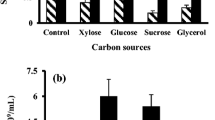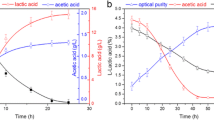Abstract
Bacillus halodurans was cultivated on wheat bran as a solid-state substrate and produced haloduracin, a bacteriocin, at about 245 AU per wheat bran. Supplementation of the bran with Lauria-Bertani broth decreased haloduracin production. However, production was stimulated by addition of Mg2SO4 and K2HPO4. The highest production was achieved at a wheat bran/moisture ratio of 1:1.8 and in the presence of 10% (w/w) Na2CO3. Under optimum conditions, the organism produced about 3,000 AU per gram dry bran.

Similar content being viewed by others
References
Anto H, Trivedi U, Patel K (2006) Alpha amylase production by Bacillus cereus MTCC 1305 using solid-state fermentation. Food Technol Biotechnol 44:241–245
Barefoot SF, Klaenhammer TR (1983) Detection and activity of lactacin B, a bacteriocin produced by Lactobacillus acidophilus. Appl Environ Microbiol 45:1808–1815
Cintas LM, Rodriguez JM, Fernandez MF et al (1995) Isolation and characterization of pediocin L50, a new bacteriocin from Pediococcus acidilactici with a broad inhibitory spectrum. Appl Environ Microbiol 61:2643–2648
Cotter PD, Hill C, Ross RP (2005) Bacterial lantibiotics: strategies to improve therapeutic potential. Curr Protein Pept Sci 6:61–75
Dieter A, Hamm A, Fiedler HP et al (2003) Pyrocoll, an antibiotic, antiparasitic and antitumor compound produced by a novel alkaliphilic Streptomyces strain. J Antibiot 56:639–646
Fricourt BV, Barefoot SF, Testin RF, Hayasaka SS (1994) Detection and activity of plantaricin F, an antibacterial substance from Lactobacillus plantarum BF001 isolated from processed channel catfish. J Food Prot 57:698–702
Geis A, Singh J, Teuber M (1983) Potential of lactic streptococci to produce bacteriocin. Appl Environ Microbiol 45:205–211
Gessesse A, Mamo G (1999) High-level xylanase production by an alkaliphilic Bacillus sp. by using solid-state fermentation. Enzyme Microb Technol 25:68–72
Höltzel A, Dieter A, Schmid DG et al (2003) Lactonamycin Z, an antibiotic and antitumor compound produced by Streptomyces sanglieri strain AK 623. J Antibiotic 56:1058–1061
Krishna C (2005) Solid-state fermentation systems:an overview. Crit Rev Biotechnol 25:1–30
Maldonado-Barragán A, Ruiz-Barba JL, Jiménez-Díaz R (2009) Knockout of three-component regulatory systems reveals that the apparently constitutive plantaricin-production phenotype shown by Lactobacillus plantarum on solid medium is regulated via quorum sensing. Int J Food Microbiol 130:35–42
Mamo G, Hatti-Kaul R, Mattiasson B (2006) A thermostable alkaline endo-β-1,4 xylanase from Bacillus halodurans S7: purification and characterization. Enzyme Microb Technol 39:1492–1498
McClerren AL, Cooper LE, Quan C et al (2006) Discovery and in vitro biosynthesis of haloduracin, a two-component lantibiotic. Proc Nat Acad Sci USA 103:17243–17248
Nilsen T, Nes IF, Holo H (2003) Enterolysin A, a cell wall-degrading bacteriocin from Enterococcus faecalis LMG 2333. Appl Environ Microbiol 69:2975–2984
Oman TJ, van der Donk WA (2009) Insights into the mode of action of the two-peptide lantibiotic haloduracin. ACS Chem Biol 4:865–874
Papagianni M, Anastasiadou S (2009) Pediocins: the bacteriocins of pediococci. sources, production, properties and applications. Microb Cell Fact 8:3
Parente E, Brienza C, Moles M et al (1995) A comparison of methods for the measurement of bacteriocin activity. J Microbiol Methods 22:95–108
Qi F, Chen P, Caufield PW (2001) The group I strain of Streptococcus mutans, UA140, produces both the lantibiotic mutacin I and a nonlantibiotic bacteriocin, mutacin IV. Appl Environ Microbiol 67:15–21
Sato M, Beppu T, Arima K (1983) Studies on antibiotics produced at high alkaline pH. Agric Biol Chem 47:2019–2027
Schillinger U, Lücke FK (1989) Antibacterial activity of Lactobacillus sake isolated from meat. Appl Environ Microbiol 55:1901–1906
Shrago AW, Chassy BM, Dobrogosz WJ (1986) Conjugal plasmid transfer (pAMβ1) in Lactobacillus plantarum. Appl Environ Microbiol 52:574–576
van der Ploeg JR (2005) Regulation of bacteriocin production in Streptococcus mutans by the quorum-sensing system required for development of genetic competence. J Bacteriol 187:3980–3989
Wescombe PA, Tagg JR (2003) Purification and characterization of streptin, a type A1 lantibiotic produced by Streptococcus pyogenes. Appl Environ Microbiol 69:2737–2747
West CA, Warner PJ (1988) Plantacin B, a bacteriocin produced by Lactobacillus plantarum NCDO1193. FEMS Microbiol Lett 49:163–165
Willey JM, van der Donk WA (2007) Lantibiotics: peptides of diverse structure and function. Annu Rev Microbiol 61:477–501
Yoganathan S, Vederas JC (2008) Fracturing rings to understand lantibiotics. Chem Biol 15:999–1001
Acknowledgments
The Ministry of Health and Medical Education of Iran is gratefully acknowledged for the financial support of A. Danesh.
Author information
Authors and Affiliations
Corresponding author
Rights and permissions
About this article
Cite this article
Danesh, A., Mamo, G. & Mattiasson, B. Production of haloduracin by Bacillus halodurans using solid-state fermentation. Biotechnol Lett 33, 1339–1344 (2011). https://doi.org/10.1007/s10529-011-0581-0
Received:
Accepted:
Published:
Issue Date:
DOI: https://doi.org/10.1007/s10529-011-0581-0




